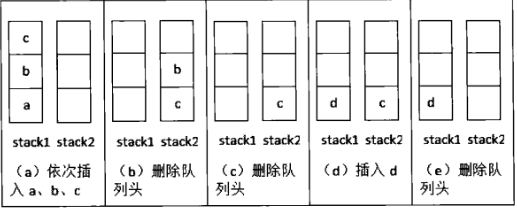两个队列实现一个栈 + 两个栈实现一个队列
面试中常出现让你手写两个队列实现一个栈,两个栈实现一个队列的问题,很是头疼!今天就仔细将我分析,思考过的Java代码给大家分享一下:(一)两个队列实现一个栈:

两个队列添加元素,哪个队列为空,由于在输出元素时,要进行相应元素的移动(除去尾部元素),所以要在对应不为空的队列进行元素的添加;在输出数据时,要进行两个队列的变相操作,不为空的队列要依次向为空的队列中添加元素,直到尾元素输出即可!
1 2 3 4 5 6 7 8 9 10 11 12 13 14 15 16 17 18 19 20 21 22 23 24 25 26 27 28 29 30 31 32 33 34 35 36 37 38 39 40 41 42 43 44 45 46 47 48 49 50 51 52 53 54 55 56 57 58 59 60 61 62 63 64 65 66 67 68 69 70 71 72 73 74 75 76 77 78 | /** * 两个队列实现一个栈 * @auther yangchao * @date 2019/7/18 */public class TwoQueueImplStack { private Queue<Integer> queue1 = new ArrayDeque<>(); private Queue<Integer> queue2 = new ArrayDeque<>(); /** * 向栈中压入数据 * @param element */ public void push(Integer element) { //两个队列为空时,优先考虑queue1 if (queue1.isEmpty() && queue2.isEmpty()) { queue1.add(element); return; } //如果queue1为空,queue2有数据,直接放入queue2 if (queue1.isEmpty()) { queue2.add(element); return; } //如果queue1为空,queue2有数据,直接放入queue2 if (queue2.isEmpty()) { queue1.add(element); return; } } /** * 取出栈中的数据 * @return */ public Integer poll() { //两个队列为空时,直接抛出异常 if (queue1.isEmpty() && queue2.isEmpty()) { throw new RuntimeException("stack is empty"); } //如果queue1为空,将queue2中的元素依次加入到 queue1, 弹出最后一个元素 if (queue1.isEmpty()) { while(queue2.size() > 1) { queue1.add(queue2.poll()); } return queue2.poll(); } //如果queue2为空,将queue1中的元素依次加入到 queue2, 弹出最后一个元素 if (queue2.isEmpty()) { while(queue1.size() > 1) { queue2.add(queue1.poll()); } return queue1.poll(); } return null; } public static void main(String[] args) { TwoQueueImplStack qs = new TwoQueueImplStack(); qs.push(2); qs.push(4); qs.push(7); qs.push(5); System.out.println(qs.poll()); System.out.println(qs.poll()); qs.push(1); System.out.println(qs.poll()); }} |
输出结果:

(二)两个栈实现一个队列:
第一个栈只负责添加元素,第二个栈在弹出元素时,首先判断当前栈是否为空,若为空就直接将其第一个栈中的数据全部压入第二个栈中,然后输出栈顶元素,即可实现队列效果;若第二个栈中有数据,添加直接将其数据压入第一个栈中,输出时直接输出第二个栈顶的元素即可!
1 2 3 4 5 6 7 8 9 10 11 12 13 14 15 16 17 18 19 20 21 22 23 24 25 26 27 28 29 30 31 32 33 34 35 36 37 38 39 40 41 42 43 44 45 46 47 48 49 50 51 52 53 54 | /** * 两个栈实现一个队列 * @auther yangchao * @date 2019/7/18 */public class TwoStackImplQueue { private Stack<Integer> stack1 = new Stack<>(); private Stack<Integer> stack2 = new Stack<>(); /** * stack1只负责压入队列元素 * @param element */ public void push(Integer element) { stack1.add(element); } /** * 取出队列顶部元素 * @return */ public Integer poll() { //若stack2为空,将 stack1 中的元素压入 stack2 if (stack2.isEmpty()) { while (stack1.size() > 0) { stack2.add(stack1.pop()); } } if (stack2.isEmpty()) { throw new RuntimeException("queue is Empty!"); } Integer head = stack2.pop(); return head; } public static void main(String[] args) { TwoStackImplQueue sq = new TwoStackImplQueue(); sq.push(1); sq.push(3); sq.push(5); sq.push(4); sq.push(2); System.out.println(sq.poll()); System.out.println(sq.poll()); sq.push(7); System.out.println(sq.poll()); }} |
输出结果:

每天进步一点点,继续加油......





【推荐】国内首个AI IDE,深度理解中文开发场景,立即下载体验Trae
【推荐】编程新体验,更懂你的AI,立即体验豆包MarsCode编程助手
【推荐】抖音旗下AI助手豆包,你的智能百科全书,全免费不限次数
【推荐】轻量又高性能的 SSH 工具 IShell:AI 加持,快人一步
· 10年+ .NET Coder 心语,封装的思维:从隐藏、稳定开始理解其本质意义
· .NET Core 中如何实现缓存的预热?
· 从 HTTP 原因短语缺失研究 HTTP/2 和 HTTP/3 的设计差异
· AI与.NET技术实操系列:向量存储与相似性搜索在 .NET 中的实现
· 基于Microsoft.Extensions.AI核心库实现RAG应用
· 10年+ .NET Coder 心语 ── 封装的思维:从隐藏、稳定开始理解其本质意义
· 地球OL攻略 —— 某应届生求职总结
· 提示词工程——AI应用必不可少的技术
· Open-Sora 2.0 重磅开源!
· 周边上新:园子的第一款马克杯温暖上架